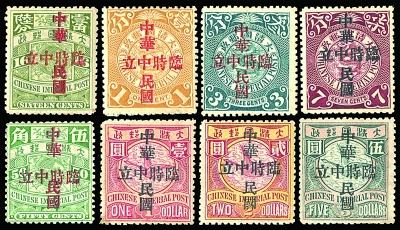(Ecns.cn)--Jointly organized by the State Post Bureau, the China Post Group Corporation, the All-China Philatelic Federation and the Jiangsu provincial government, the 27th Asian International Stamp Exhibition was held in Wuxi, Jiangsu Province, from Nov. 11 to 15, displaying 1,300 precious stamps from 26 Inter-Asian Philatelic Federation members.
As part of the exhibition, a precious stamp auction was held on the third day, which attracted a number of stamp lovers. Presided over by the Shanghai Hosane Auction Company, the auction raked in 13 million yuan (US$2.04 million).
Over 900 articles collected in half a year
In order to organize the auction, Shanghai Hosane started preparing about half a year ago, traveling around the world collecting over 900 stamps and other articles, such as envelopes dating from the Qing Dynasty to the New China.
Among the many rare items, there was a bright red revenue stamp numbered "137" that stood out. The starting bid for the stamp was 600,000 yuan (US$94,528), and after three bids it sold for 782,000 yuan (US$123,201), including the brokerage fee.
"I expected the stamp to be sold at a higher price," said Ma Zhenjie, a reporter from a stamp collection magazine. "Since the original notes of such red revenue stamps are rarely seen in China, I thought the price for this one might be higher."
The stamp bore three degrees of red and has historically been mistaken as a revenue stamp, so later people called it a "red revenue stamp." It was first printed by Shanghai Customs for use on declaration forms in Sept. 1896, but its use was eventually rejected.
In 1897, the Qing government was eager to develop a postal service and needed more kinds of stamps, so it adapted the "red revenue stamps" by adding surcharges to them. But first, the government sent 200 of the notes with no surcharges on them as gifts to senior government officials and members of the imperial family. The stamp that sold at the auction was one of the notes that were never surcharged.
In addition, there was also the first complete set of stamps used after the Revolution of 1911. Most of the stamps sold for more than 200,000 yuan (US$31,509).
Stories behind the stamps
The high selling price of the stamps was one reason why the exhibition attracted many people. Another reason was the stories behind the stamps and their collectors.
Article number "358" only sold for 13,800 yuan (US$2,174) at the auction, but the story behind it makes it special. It was once sent from the United States to Nanjing, capital city of Jiangsu Province.
The letter was mailed on Dec. 10, 1937, from the U.S. to Nanjing, but it never reached its intended destination, because on Dec. 13 of the same year the Japanese began their bloody massacre in Nanjing.
The next year, on Jan. 29, the letter was transferred to Shanghai and returned to San Francisco on Feb. 21, 1938, with the sentence "Return to sender, Communication with Nanking temporarily suspended" on the envelope.
The stamp and the letter were eventually returned to sender, but because of its connection to an historical event, the letter was endowed with a special meaning. According to research, there are only two letters like it that have been found.
There is another story about a stamp collector that also attracted people's interest, involving a German collector who provided 119 stamps for the auction.
The man was sent to China as a foreign expert during the 1970s. Though he did not know Chinese he was very interested in Chinese culture, and began collecting stamps from different times. He has been doing so for 35 years.
As many of his stamps represent different times of China, the man's collection attracted many stamp lovers to the exhibit.
The five-day event also featured exhibitions of stamp designs, forums on stamp collecting and a competition of stamp design and fabrication.


















